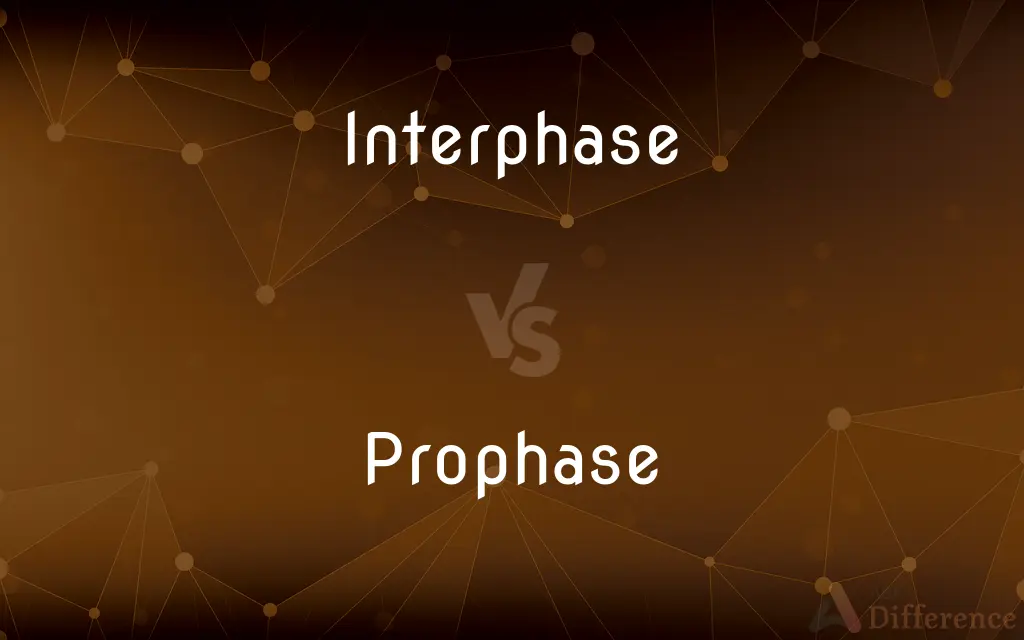Interphase vs. Prophase — What's the Difference?
By Tayyaba Rehman & Maham Liaqat — Updated on April 26, 2024
Interphase is a cell cycle phase where cells prepare for division by replicating DNA and increasing in size, while prophase is the first stage of mitosis where chromosomes condense and the nuclear envelope breaks down.

Difference Between Interphase and Prophase
Table of Contents
ADVERTISEMENT
Key Differences
Interphase is characterized by the cell's preparation for division, encompassing three sub-phases: G1, S, and G2. During this phase, the cell grows, duplicates its DNA, and synthesizes proteins necessary for mitosis. Prophase, on the other hand, marks the beginning of mitosis, featuring the condensation of chromatin into visible chromosomes, and the initiation of spindle formation as the centrosomes begin to move to opposite poles.
During interphase, the cell's DNA is loosely packed in the form of chromatin, making it accessible for transcription and DNA replication. In contrast, during prophase, DNA condenses into tightly packed chromosomes, each consisting of two sister chromatids, which makes them less accessible but easier to separate during cell division.
In interphase, the nuclear envelope is intact, enclosing a well-defined nucleus, and the nucleolus is visible, active in ribosomal RNA synthesis. Whereas in prophase, the nuclear envelope begins to disintegrate, and the nucleolus fades, signaling the cessation of transcriptional activities and the shift towards division.
The centrosomes, which duplicate during the later stages of interphase, play a crucial role in prophase. They migrate to opposite poles of the cell, aiding in the formation of the mitotic spindle, which is essential for chromosome movement during mitosis. This migration does not occur during interphase, where the centrosomes are primarily involved in organizing the interphase microtubule network.
Interphase is generally longer than prophase, constituting about 90% of the cell cycle, highlighting its role in preparing the cell for division rather than the division itself. Prophase, while shorter, is dynamically involved in the mechanical processes that lead to the physical separation of chromosomes.
ADVERTISEMENT
Comparison Chart
Main Purpose
Preparation for mitosis
Initiation of chromosome separation
Chromatin State
Loosely packed, accessible for replication and transcription
Condensed into visible chromosomes
Nuclear Envelope
Intact
Begins to break down
Nucleolus
Visible and active
Fades and ceases activity
Duration in Cell Cycle
Approximately 90% of the cycle
Much shorter, marks the start of mitotic events
Compare with Definitions
Interphase
The longest phase of the cell cycle, where the cell grows and duplicates its DNA.
During interphase, the cell's volume increases as it prepares for division.
Prophase
The first stage of mitosis, where chromosomes condense.
During prophase, chromatin fibers become visible as discrete chromosomes.
Interphase
DNA is in the form of chromatin, facilitating transcription and replication.
The accessibility of chromatin during interphase supports essential cellular functions.
Prophase
Marked by the breakdown of the nuclear envelope.
The disintegration of the nuclear envelope during prophase allows spindle fibers to contact chromosomes.
Interphase
Features an intact nuclear envelope and a visible nucleolus.
The nucleus during interphase is well-defined and active in RNA synthesis.
Prophase
Involves the disappearance of the nucleolus and cessation of transcription.
As prophase progresses, the cell suspends most normal functions to focus on division.
Interphase
Characterized by three sub-phases: G1, S, and G2.
In the S phase of interphase, DNA replication occurs.
Prophase
Features the formation of the mitotic spindle from centrosomes.
Spindle fibers emerging from centrosomes during prophase are crucial for chromosome movement.
Interphase
Essential for cell growth and preparation for mitosis.
Without a proper interphase, cells cannot accurately duplicate their genetic material.
Prophase
Prophase (from the Greek πρό, "before" and φάσις, "stage") is the first stage of cell division in both mitosis and meiosis. Beginning after interphase, DNA has already been replicated when the cell enters prophase.
Interphase
Interphase is the portion of the cell cycle that is not accompanied by gross changes under the microscope, and includes the G1, S and G2 phases. During interphase, the cell grows (G1), replicates its DNA (S) and prepares for mitosis (G2).
Prophase
The first stage of mitosis, during which the chromosomes condense and become visible, the nuclear membrane breaks down, and the spindle apparatus forms at opposite poles of the cell.
Interphase
The stage of a cell between two successive mitotic or meiotic divisions.
Prophase
The first stage of meiosis, constituted by a series of events that include the thickening and coiling of the chromosomes, synapsis of homologous chromosomes, tetrad formation, and crossing over.
Interphase
(biology) The stage in the life cycle of a cell between two successive mitotic or meiotic divisions.
Prophase
The first stage of mitosis, during which chromatin condenses to form the chromosomes.
Interphase
(mechanical engineering) An indistinct region in the interface between two substances in composite materials.
Prophase
The first stage of meiosis.
Interphase
Between phases
Prophase
The first stage of meiosis
Prophase
The first stage of mitosis
Prophase
A critical preparatory phase for chromosomal separation.
Proper chromosome condensation in prophase is essential for their subsequent accurate distribution.
Common Curiosities
How does prophase differ from other phases of mitosis?
Prophase is distinct in that it involves the initial condensation of chromosomes and the beginning of the nuclear envelope's breakdown.
What role do centrosomes play in prophase?
Centrosomes help organize the mitotic spindle, which is critical for the movement and separation of chromosomes during mitosis.
Can interphase be considered part of mitosis?
No, interphase is a preparatory phase that occurs before mitosis begins and is not considered a part of mitosis itself.
What are the sub-phases of interphase and their functions?
Interphase consists of G1 (cell growth), S (DNA synthesis), and G2 (preparation for mitosis), each essential for proper cell division.
What is the main function of interphase in the cell cycle?
Interphase is primarily focused on preparing the cell for division by growing, duplicating DNA, and synthesizing necessary proteins.
Why is DNA replication important during interphase?
DNA replication during interphase ensures that each daughter cell receives an identical set of chromosomes during division.
How do the physical states of DNA differ between interphase and prophase?
During interphase, DNA is in the form of accessible chromatin, while in prophase, it condenses into distinct, tight chromosomes.
How does the nuclear envelope change during prophase?
The nuclear envelope breaks down during prophase, allowing the spindle fibers to interact with the chromosomes.
What is the significance of chromosome condensation in prophase?
Chromosome condensation during prophase is crucial for the visibility and separation of chromosomes during cell division.
What happens to the nucleolus during prophase?
The nucleolus disappears during prophase, reflecting the cell's shift away from its normal functions towards mitosis.
Share Your Discovery

Previous Comparison
Concert vs. Gig
Next Comparison
Cleavage vs. FractureAuthor Spotlight
Written by
Tayyaba RehmanTayyaba Rehman is a distinguished writer, currently serving as a primary contributor to askdifference.com. As a researcher in semantics and etymology, Tayyaba's passion for the complexity of languages and their distinctions has found a perfect home on the platform. Tayyaba delves into the intricacies of language, distinguishing between commonly confused words and phrases, thereby providing clarity for readers worldwide.
Co-written by
Maham Liaqat















































